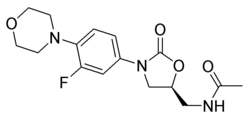Site infections are a major cause of surgical morbidity. The proportion of infections caused by methicillin-resistant Staphylococcus aureus (MRSA) has been increasing rapidly and is now believed to be at least 30 percent. MRSA infections have substantially higher morbidity, mortality, and health care costs than infections caused by other pathogens. Because most antibiotics are ineffective against MRSA, vancomycin (Vancocin) has become the most commonly used treatment even though it has limited effectiveness and requires intravenous administration. A new class of drugs, oxazolidinones, is available in oral formulations that may have effectiveness comparable with vancomycin. Weigelt and colleagues compared linezolid (Zyvox) with vancomycin in a randomized, open-label clinical trial of patients with complicated surgical site infections.
Patients were selected for the study if they had local erythema of skin and soft tissues requiring hospital admission, plus at least one feature of systemic infection such as fever, hypothermia, hypotension, elevated white blood cell count, or more than 15 percent immature neutrophils. Patients younger than 18 years and those with gram-negative infections were excluded from the study. Patients with serious medical comorbidities or infected devices, those already receiving an investigational medication, and those with contraindications to the study medications also were excluded. On entry to the study, demographic data were gathered with extensive documentation of the infection and clinical condition. Patients were not permitted any antibiotic medication with anti-MRSA activity for 48 hours before randomization. The patients were randomized to receive linezolid 600 mg twice daily or vancomycin 1 g every 12 hours. Patients were treated from four to 21 days.
The researchers considered outcomes from several perspectives. Patients in the intent-to-treat group received at least one dose of the study medication. The modified intent-to-treat group included patients who had culture-confirmed gram-positive pathogens at baseline. The clinically evaluable group included all patients who received at least four days of therapy and returned for test-of-cure evaluation. The primary outcome was clinical response and microbiologic cure. Clinical response documented the resolution of signs and symptoms on a three-point scale. Microbiologic cure used a four-point scale to document eradication of the pathogen, microbiologic persistence, indeterminate results, or missing data.
Although linezolid had better clinical outcomes than vancomycin in all groups, the difference did not reach statistical significance. Conversely, the microbiologic eradication rate was 84 percent in the 49 evaluable patients who received linezolid compared with 58 percent eradication in the 49 comparable patients treated with vancomycin (P = .0073). Similar results were obtained when only patients with documented MRSA were considered (i.e., microbiologic cure in 87 percent for linezolid compared with 48 percent for vancomycin). Linezolid also had a better microbiologic cure rate in patients with methicillin-sensitive organisms, but this difference did not reach statistical significance (89 percent compared with 56 percent). Adverse events were reported by 71 percent of patients assigned to linezolid and by 58 percent of the vancomycin group. Most adverse events were mild or moderate, but drug discontinuation was attributed to a drug adverse event in 8 percent of linezolid patients and 4 percent of vancomycin patients.
The authors conclude that clinical success rates were similar in patients treated with linezolid and vancomycin; however, significantly more patients treated with linezolid achieved microbiologic cure. The authors emphasize the growing significance of resistant infections in surgical practice and the need to develop effective oral agents.
ANNE D. WALLING, M.D.
Weigelt J, et al. Linezolid eradicates MRSA better than vancomycin from surgical-site infections. Am J Surg December 2004;188:760-6.
COPYRIGHT 2005 American Academy of Family Physicians
COPYRIGHT 2005 Gale Group



